Steenboks are small and agile antelope, native to Southern Africa, having fawn to rufous coats, upright and slender horns and acrobatic stotting display. In the vast savannas and grasslands of Southern Africa, the captivating creature roams the wilderness, gracefully navigating its natural habitat with poise and elegance.
The “Steenbok”, also known as steinbuck or steinbok, scientifically known as ‘Raphicerus Campestris’, is a small and shy antelope species that holds a special place in the hearts of wildlife activists and enthusiasts. In this article, we will explore the world of Steenbok from its characteristics to family, and conservation status and appreciate the significance of preserving the elegant animal for future generations.
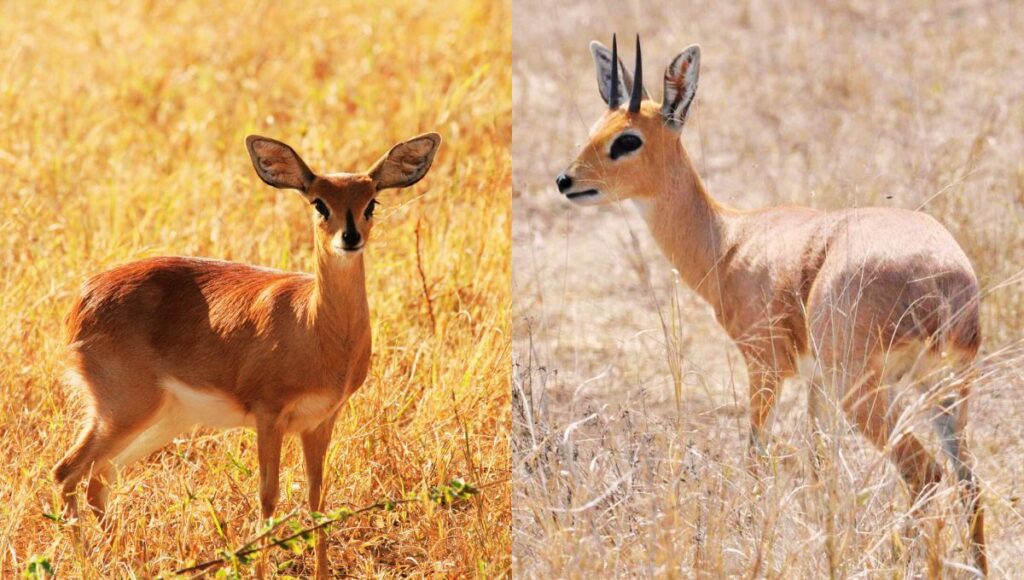
Table of Contents
Steenbok: In a Glimpse:
| Common Name: | Steenbok |
| Scientific Name: | Raphicerus campestris |
| Life Span: | 10-12 years |
| Adult Weight: | 9-15 kg |
| Height and Length of Adult: | 75-90 cm head and body length 50 cm height at standing |
| Family: | Solitary in Nature but monogamous |
| Diets: | leaves, flowers, shoots, and fruits of shrubs |
| Main Predators: | wild dogs,caracal, jackals, leopard, martial eagle |
| IUCN Status: | Least Concern |
| Habitats: | mix of grasslands, savannas, shrublands, and even semi-desert regions. |
| Distribution: | South Africa, Namibia, Botswana, Zimbabwe, Mozambique, and Angola. |
| Population Density: | 1-4 Steenboks/Sq. km |
| No. Of Subspecies: | 24 |
Everything About Steenbok:
Scientific Classification:
| Domain: | Eukaryota |
| Kingdom: | Animalia |
| Phylum: | Chordata |
| Class: | Mammalia |
| Order: | Artiodactyla |
| Family: | Bovidae |
| Subfamily: | Antilopinae |
| Genus: | Raphicerus |
| Species: | R. campestris |
Physical Characteristics of Steenbok:
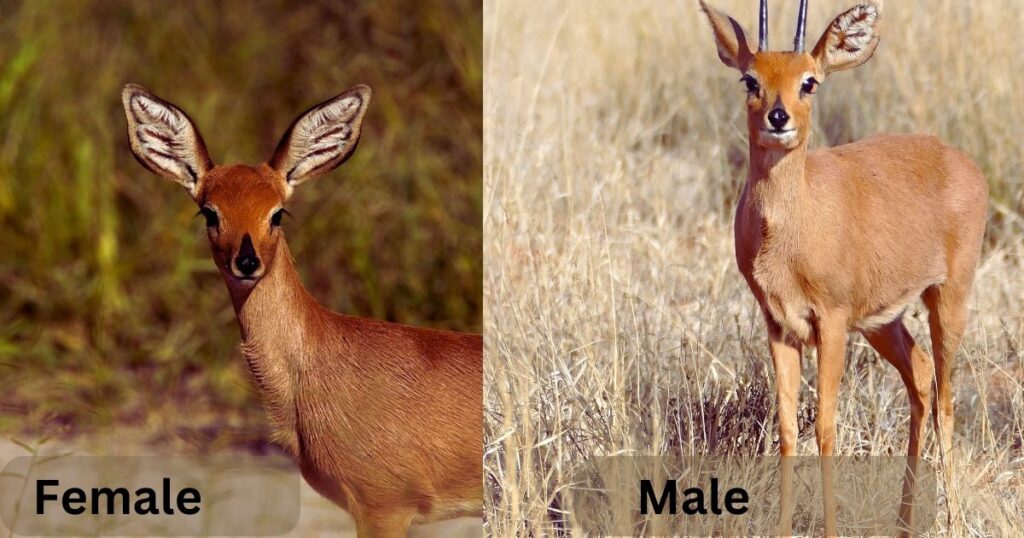
Steenbok is a compact and dainty antelope, that resembles a small Oribi standing at around 50 centimetres or 20 inches at the shoulders, 75-90 cm head and body length and weighing between 9-15 kgs, showcases sexual dimorphism. The males are slightly larger and bigger than the females and they both exhibit the unique and distinguished features of large and rounded ears.
The coat of the Steenbok depends on its habitat, ranging from rich chestnut or reddish brown or rufous coloured coats in open grassland to fawn or yellowish brown coats in denser vegetation. A white underside contrasts with its body colour and white rings encircle each eye, adding additional charm to the Steenbok.
One of the most fascinating traits of the male Steenbok is the long, pointed and upright horns which can measure up to 15 centimetres (6 inches) in length. Only the male Steenboks bear horns. These horns are very slender, with a slight backward curve and are used primarily for territorial defence.
A black crescent shape between the ears and a long and thick black bridge to the glossy nose are the other elegant traits of Steenboks.
Distribution and Habitats:
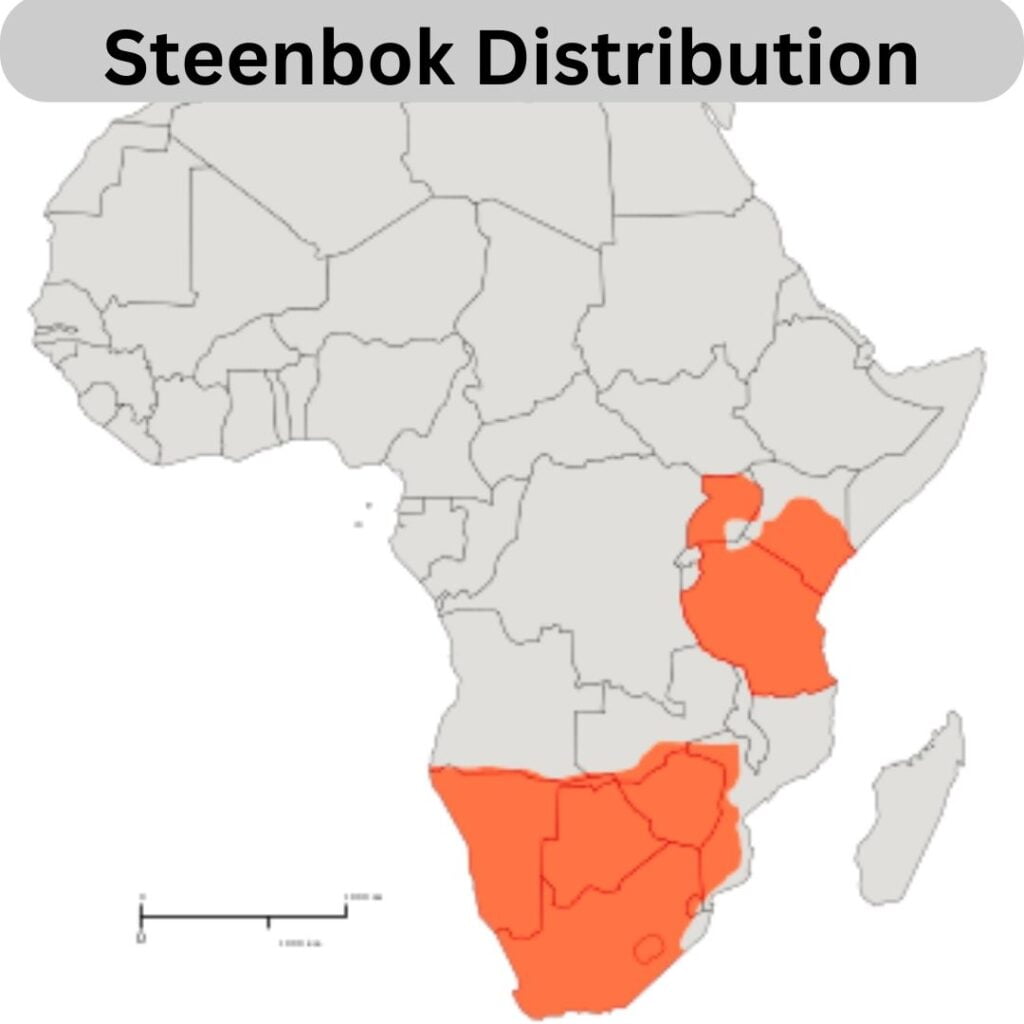
As Steenbok can adapt remarkably to nature, they can be found in a wide and diverse range of habitats across the Southern parts of Africa. Steenboks are generally found in areas with a mix of grasslands, savannas, shrublands, and even semi-desert regions. They often prefer a landscape which provides dense vegetation as well as open spaces. Dense vegetation allows them to hide from predators and open spaces help them to graze.
According to MSW3 (Mammal Species of the World), up to 24 subspecies have been found in countries like South Africa, Namibia, Botswana, Zimbabwe, Mozambique, and Angola. Each region’s specific climate and vegetations shape its physical attributes and behaviour which leads to variation in colours and adaptations.
Behaviour and Social Structure:
Steenboks are small in size but compensate with their highly adaptive behaviour and remarkable survival strategies. Although it is primarily a solitary creature but occasionally individuals prefer to roam and forage in pairs. The solitary lifestyle is very essential for them to safeguard from potential threats and maintain a stable food supply.
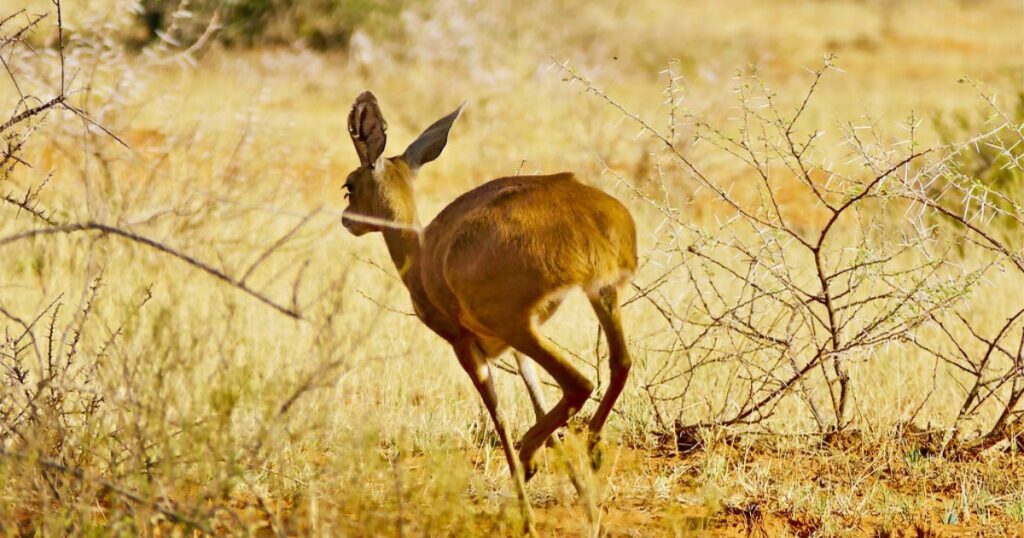
Despite being a solitary animal, the small antelope is famous for its monogamous nature. The bonded pairs often occupy overlapping territories which is relatively small in size (approximately 20 to 30 hectares) which they defend from intruders during the mating season.
While in danger, Steenboks exhibit a very agile and acrobatic display of leaping, known as ‘stotting’. It can jump very high in the air and lands on stiff legs, it can quickly change direction and fools the predator. This behaviour not only helps to escape from predators but signals the other steenboks about the potential danger.
Although the animals are active during the day and night. During summer, they often rest under shades of large trees and time spent feeding at night increases.
Diets and Feeding Habits:
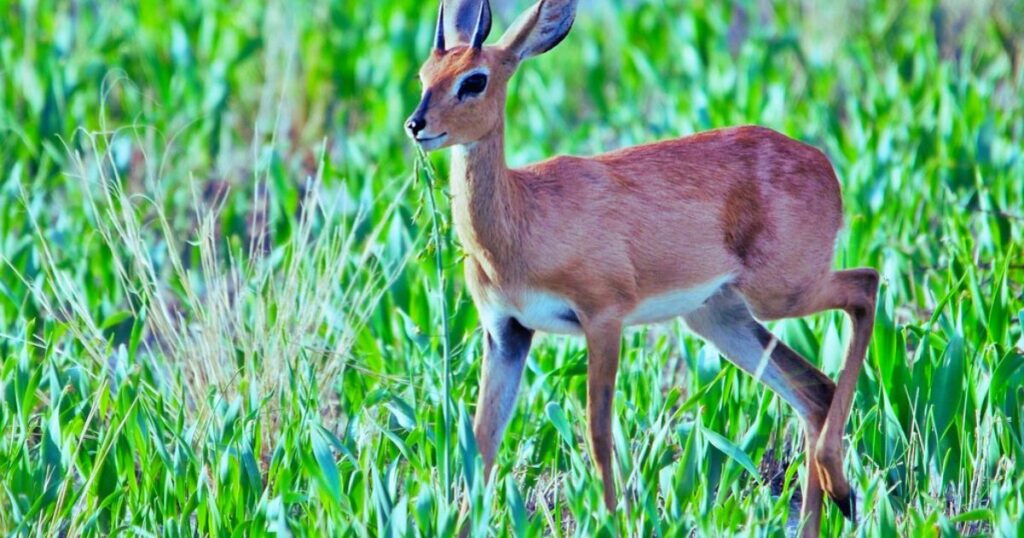
Steenboks are predominantly primary consumers. They primarily feed on leaves, flowers, shoots, and fruits of shrubs and small trees. They can easily adapt to arid environments with a limited supply of water and foods using their efficient digestive system to extract maximum nutrition from the plants they consume.
In times of the unavailability of food and water, Steenboks are also known to practice ‘Geophagy’, which means they consume soil and clay. This process helps to provide essential minerals and aids in their diets.
Reproduction:
| Gestation period: | 170 days |
| Litter size: | 1 |
| Weaning: | 80-90 days |
| Sexual maturity: | Female – 6-7 months Males- 9 months |
| Breeding season: | Spring and Summers |
| Weight of Infants: | 1 kg or 2.2 lbs |
The Steenboks are generally solitary animals unless they come together to mate. Males become sexually mature at 9 months of age whereas females become mature at 6-7 months of age.
They are monogamous by nature and usually, the pair lives in the same territory but independently. Their territory ranges between 50 to 75 acres and is marked by dung middens or dung hills.
The males become very aggressive during the female’s oestrus, They often engage in “bluff-and-bluster” type rivalry with other males. Although the breeding takes place throughout the year, the preferable season is spring and summer; usually from October to December.
Sometimes females breed twice a year. The gestation period can last up to 170 days. The litter size is generally 1 but sometimes they give birth to more than 1 child. Weighing around 1 kg at the time of birth, they can stand and walk immediately after birth and are weaned at 80-90 days. From 2 weeks of age, the babies can eat grass.
Predators:

Despite their agility and cautious nature, Steenbok faces a lot of threats from the predators within their ecosystem. Steenboks are known to have extraordinary survival instincts, relying on their acute senses to identify danger and dodge their predators. They not only evade the predators but also with their slick movement they often signal other Steenboks about the potential danger.
Some of their main predators are leopards, cheetahs, African wild dogs, caracals, martial eagles and pythons. But the infants of Steenboks are often hunted by small predators like Jackals, raptors, monitor lizards, and baboons.
Life Span:
Usually, the life span of a Steenbok is 10-12 years. Sometimes they can live up to 14 years.
Threats:

The Steenboks are facing challenges due to various anthropogenic factors and habitat loss. The rapid expansion of human settlement, agriculture and infrastructure in Southern Africa encroaches on their natural habitats and affects their natural lifestyle.
Illegal hunting and poaching impose additional threats to the population. The demand for meats and their use in traditional medicine make Steenboks more vulnerable. Although the number of Steenboks in Africa is nowhere near danger, extensive conservation measures are necessary for their long-term survival.
Conservation Status of Steenbok:
Unlike many African Species, the population of Steenboks are generally stable or increasing. It is estimated that the current population is more than 6,00,000 in Southern Africa.
Steenboks are listed as “Least Concern” in the IUCN Red List of Threatened Species. But the species is not listed in CITES so far. To read more about the IUCN Red List of Threatened Species, you can click here.
Frequently Asked Questions (FAQs):
Are Steenboks endangered?
No, It is listed as “Least Concern” in the IUCN Red List. The Steenbok Population in Africa is stable or increasing with time. Currently, it is estimated there are around 6,00,000 Steenboks in the Southern Parts of Africa.
What is a group of Steenbok called?
Steenbok is a solitary animal, rarely found in groups. The group names of Steenboks are Cohort, Herd, Zeal, Dazzle, etc.
Does Steenbok mate for life?
Steenboks are known as solitary animals but they are monogamous by nature. It is believed that they are mates for life. The male and female Steenbok usually live in the same territory but independently. They come closer to each other only for meetings.
How long is a Steenbok Pregnant?
Steenboks usually breed once a year, sometimes twice. The gestation period of Steenboks is around 170 days long.
Is a Steenbok Duiker?
Steenbok and Duiker both are small antelope found in Southern Africa but they are not the same.
What is the difference between a Steenbok and a Duiker?
Steenbok has ‘Satellite Dish’ type ears with deep marks inside. Duiker has leaf-shaped ears.
Duiker has a slit-shaped scent gland close to the eyes, sometimes mistaken as scars. Steenboks have circular pre-orbital white glands made of fur around the eyes, making them more charming.
The tail lengths also differ. The Duiker (9-11 cm) has a comparatively longer tail than the Steenboks (4-6 cm).
Because of its grace and charm, Steenbok represents Southern Africa’s vast biodiversity and landscape. While we appreciate its beauty we must be aware of the threats that the beautiful antelope faces. It is our responsibility to ensure its survival for future generations by taking proper conservation measures, promoting sustainable practices creating awareness among the local people about the species and securing its place in the wild where it actually belongs.